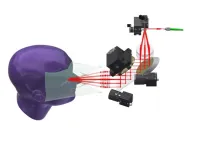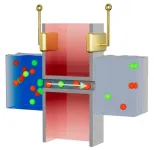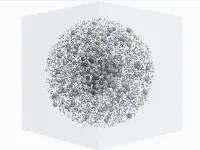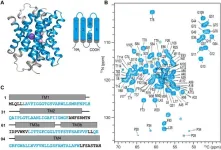(Press-News.org) A collaboration between researchers at the University of Illinois Urbana-Champaign and Duke University has developed a robotic eye examination system, and the National Institutes of Health has awarded the researchers $1.2 million to expand and refine the system.
The researchers have developed a robotic system that automatically positions examination sensors to scan human eyes. It currently uses an optical scan technique which can operate from a reasonably safe distance from the eye, and now the researchers are working to add more features that will help it perform most steps of a standard eye exam. These features will require the system to operate in closer proximity to the eye.
“Instead of having to spend time in a doctor’s office going through the manual steps of routine examinations, a robotic system can do this automatically,” said Kris Hauser, a U. of I. computer science professor and the study’s principal investigator. “This would mean faster and more widespread screening leading to better health outcomes for more people. But to achieve this, we need to develop safer and more reliable controls, and this award allows us to do just that.”
Automated medical examinations could both make routine medical services accessible to more people and allow health care workers to treat more patients. However, medical examinations present unique safety concerns compared to other automated processes. The robots must be trusted to operate reliably and safely in proximity to sensitive body parts.
A prior system developed by Hauser and his collaborators was a robotic eye examination system that deploys a technique called optical coherence tomography which scans the eye to create a three-dimensional map of the eye’s interior. This capability allows many conditions to be diagnosed, but the researchers want to expand the system’s capabilities by including a slit eye examiner and an aberrometer. These additional features require the robot arm to be held within two centimeters of the eye, highlighting the need for enhanced robotic safety.
“Getting the robot within two centimeters of the patient’s eye while ensuring safety is a bit of a new concern,” Hauser said. “If a patient’s moving towards the robot, it has to move away. If the patient is swaying, the arm has to match their movement.”
Hauser likened the control system to those used in autonomous vehicles. While the system can’t react to all possible human behaviors, he said, it must prevent “at-fault collisions” like self-driving cars must do.
The award will enable the researchers to conduct large-scale reliability testing. An important component of these tests is ensuring that the system works for as many people as possible. To achieve this, the researchers have developed a second robot that will use mannequin heads to emulate unexpected human behaviors. Moreover, the second robot will automatically randomize the heads’ appearance with different skin tones, facial features, hair and coverings to help the researchers understand and mitigate the effects of algorithmic bias in their system.
The system will be designed for use in clinical settings, but Hauser imagines that one day such systems could be used in retail settings much like blood pressure stations.
“Something like this could be used in an eyeglass store to scan your eyes for the prescription, or it could give a diagnostic scan in a pharmacy and forward the information to your doctor,” he said. “This is really where an automated examination system like this would be most effective: giving as many people access to basic health care services as possible.”
***
Duke University professors Jospeh Izatt of biomedical engineering and Anthony Kuo of ophthalmology are co-principal investigators.
The award, cosponsored by the National Robotics Initiative, will be distributed over three years.
END
NIH awards researchers $1.2M to develop robotic eye examination system
2023-09-22
ELSE PRESS RELEASES FROM THIS DATE:
Nanofluidic device generates power with saltwater
2023-09-22
There is a largely untapped energy source along the world’s coastlines: the difference in salinity between seawater and freshwater. A new nanodevice can harness this difference to generate power.
A team of researchers at the University of Illinois Urbana-Champaign has reported a design for a nanofluidic device capable of converting ionic flow into usable electric power in the journal Nano Energy. The team believes that their device could be used to extract power from the natural ionic flows at seawater-freshwater boundaries.
“While our design is still a concept at this stage, it is quite versatile and already ...
New program helps health professionals and community members determine health risks and create medical interventions for people experiencing homelessness
2023-09-22
New Program Helps Health Professionals and Community Members Determine Health Risks and Create Medical Interventions for People Experiencing Homelessness
A consortium of population health professionals, physicians, frontline staff, and community partners in Toronto established the Community Assessment and Risk Evaluation (CARE) program, a rapid risk assessment and clinical population medicine intervention to respond to challenges faced by people experiencing homelessness (PEH). The intervention also helped characterize health needs and mitigate risks among this population. ...
ISSCR Kicks off São Paulo International Symposium today in Ribeirão Preto, Brazil
2023-09-22
The unique symposium, taking place 22-24 September 2023, is designed to highlight progress in the continuum of stem cell science from early development into clinical applications. Scientists from Latin America and across the globe are convening to share their latest stem cell research in areas such as pluripotency and early development and its adult counterpart, tissue stem cells and regeneration. Advances in understanding cellular plasticity through reprogramming and directed differentiation will be showcased as will the emerging field of tissue self-organization dynamics and innovative new technologies and tools that are driving the field forward. The program will be capped ...
Texas A&M researchers show endangered parrot species is thriving in urban areas
2023-09-22
A Texas A&M-led research team has discovered that a population of endangered red-crowned parrots is thriving in urban areas of South Texas. The parrots are a unique case, considering that many animal species are affected negatively by the expansion of human urban areas, which can lead to deforestation and pollution of natural habitats.
These mostly green parrots, which have a cluster of bright red feathers on their heads, are also an unusual example of a species that has adapted well in the face of poaching and the pet trade ...
Kinase-targeted therapy in subsets of colorectal cancer
2023-09-22
“We have summarized some of our findings regarding the response of various subsets of CRC to kinase inhibitors [...].”
BUFFALO, NY- September 22, 2023 – A new editorial paper was published in Oncoscience (Volume 10) on June 27, 2023, entitled, “Kinase-targeted therapy in subsets of colorectal cancer.”
In this new editorial, researchers Patricia M. Gomez Barila and Jan Paul Medema from the University of Amsterdam and Amsterdam University Medical Centers discuss colorectal cancer (CRC) — one of the most commonly diagnosed cancers and the second leading cause of cancer-related deaths worldwide. Early diagnosis and adequate treatment are crucial ...
Sylvester Research: Socioeconomic status linked with outcomes and survival in patients treated for non-small cell lung cancer
2023-09-22
MIAMI, FLORIDA (Sept. 22, 2023) – Researchers at Sylvester Comprehensive Cancer Center at the University of Miami Miller School of Medicine found an association between “social determinants of health” and outcomes and survival in patients undergoing surgery and treatment for non-small cell lung cancer.
The findings are based on a statistical scoring system the researchers developed that consolidates and analyzes several measures of socioeconomic status and related factors.
“We believe our social determinants of health scoring system is the first to provide a composite perspective on many of the ...
Scientists reveal marvellous x-ray mask absorber in the active galaxy NGC 6814
2023-09-22
A research team led by Prof. WANG Junxian from the University of Science and Technology of China (USTC) of the Chinese Academy of Sciences (CAS) revealed a clumped, multi-component eclipsing absorber in a study of X-ray occultation events in the active galaxy NGC 6814. The results were published in Monthly Notices of the Royal Astronomical Society on Aug. 23.
Active galactic nuclei have strong X-ray emission originating in a compact region near the supermassive black hole, the so-called corona region. When an absorbing ...
Tiny bubbles could reveal immune cell secrets and improve treatments
2023-09-22
UNIVERSITY PARK, Pa. — Macrophages are little cells vital to the immune system and could possibly inform cell-based therapies for a variety of medical conditions. However, realizing the full potential of macrophage therapies relies on being able to see what these cellular allies are doing inside our bodies, and a team of Penn State researchers may have developed a way to watch them do their thing.
In a study published in the journal Small, the Penn State researchers report a novel ultrasound imaging technique to view macrophages continuously in mammal tissue, with potential for human ...
Solid-state NMR unveils fluoride ion channel permeation mechanism
2023-09-22
On August 23, 2023, a research team led by SHI Chaowei from the University of Science and Technology of China (USTC) of the Chinese Academy of Sciences (CAS) published a paper titled "Fluoride permeation mechanism of the Fluc channel in liposomes revealed by solid-state NMR" in Science Advances. The team adopted the fluoride ion channel protein Fluc-Ec1 combined with deuterium substitution and 19F labeling methods, paving a new path for membrane protein nuclear magnetic resonance (NMR) research.
NMR not only provides insights into molecular structures ...
Earth’s crust, tectonic plates gradually formed, geoscientists find
2023-09-22
UNIVERSITY PARK, Pa. — The Earth’s crust continued a slow process of reworking for billions of years, rather than rapidly slowing its growth some 3 billion years ago, according to a Penn State-led research team. The new finding contradicts existing theories that suggest the rapid formation of tectonic plates earlier in Earth’s history, researchers said.
They published the research in Geochemical Perspectives Letters.
The work may help answer a fundamental question about our planet and could hold clues as to the formation of other planets, according to lead author ...








